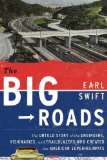The Big Roads
The Big Roads, by Earl Swift, tells the story of America’s highways. The book begins by exploring the era when a highway was merely a dirt road, and ends with a look at the lasting impact of the Interstate Highway System. Of particular interest to urbanists is the recurring belief from the system’s designers that building limited-access highways in cities would make them more hospitable places to live. Arguably the most important idea explored is that President Eisenhower isn’t the most important person in the creation of the Interstate Highway System that bares his name, a number of figures had done the bulk of the legwork before his election, including President Franklin Delano Roosevelt.
Much of the book focuses on the behind-the-scenes bureaucrats that made our highways what they are. Figures including Thomas MacDonald (nicknamed The Chief) and Frank Turner are highlighted in detail, and a spotlight is shown on their pioneering work on the technical details of highway design. These men are the real fathers of the Interstate Highway System, having spent their professional lives lobbying and designing the highway system we have today. Ironically, Turner himself rarely drove to work a frequent rider of mass transit (calling to mind New York City road builder Robert Moses, who himself never obtained a driver’s license), despite his work to build thousands of miles of roads for private automobiles.
The Interstate Highway System was conceived in an era when cities were gridlocked, and suburbs were beginning to sprawl (yet another book dispelling the notion that the Interstate Highway System was the originator of sprawl, like Fogelson’s Downtown). Cities weren’t the most hospitable place when the system was conceived for a number of reasons, but despite the success and positive reception limited-access highways had in connecting cities they weren’t welcomed by everyone to urban cores. This gave way to the freeway revolts, particularly in Baltimore, which The Big Roads explores in detail. Swift also pays much attention to the work of Lewis Mumford, who originally advocated for superhighways, but ultimately became one of the leading national critics of them because of the damage they would do to urban communities. The book notes that even Eisenhower himself appeared to be shocked by the affects the system would have on cities, to which the President claimed to have envisioned a rural-only system that ended in beltways after getting stuck in a traffic jam on an interstate highway in Washington D.C. The takeaway that has stayed with me is the way the author and others in the book portray urban highways, that the highways from high above appear attractive and logical, but that their ground-level impact divides communities and leaves a lot to be desired.
The Big Roads is definitely an interesting read. The notion of reading a book about career bureaucrats seems nauseating, but Earl Swift manages to weave their personal stories with the story of America’s love affair with the open road in a way that is both educational and engaging. The evolution of America’s highways is something that has significantly shaped our way of life, largely with unintended consequences both good and bad. Earl Swift does an excellent job of telling the story of how we went from empty dirt-roads to congested urban expressways.
Final Rating: 4 out of 5 stars, difficult topic, good execution, enjoyable read, informative
Urban Myth or Fact: You may have heard that every fifth mile of interstate was designed so that planes could land on it in an emergency. Turner did attempt to accomplish something like this in his designs after discussions with the military, but ultimately decided it was impossible to serve two masters and that the interstates were strictly for ground traffic. It’s a myth.
Quote of the Book: Lewis Mumford – “Part of the tragedy is that the cities themselves have rushed with a strange sense of urgency to cooperate in their own mutilation.”























Strangely enough, while the there may not have been intention to land planes on the interstate highway, in the mid-sixties when the the Interstate Highway to Tomah Wisconsin was till under construction, the piolet of a small private aircraft could not find the small private airfield just east of downtown Tomah (Bloyer Field today). His cockpit filling with smoke, he put his plane down on the yet to be opened Interstate for an emergency landing. Later, after repairs were completed, he took off for his intended destination.